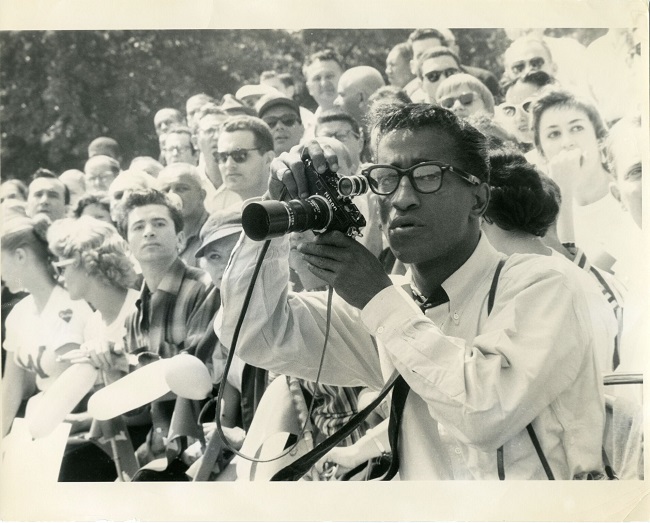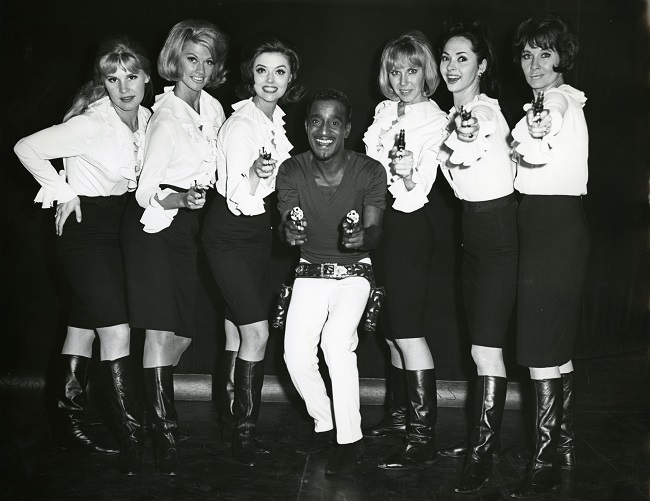
Filmmaker and editor Samuel D. Pollard vividly remembers taking the subway from 96th Street to 72nd Street in his hometown, East Harlem, N.Y., as a kid. The further he traveled, the more the Emmy and Peabody award winner would notice how black people were less and less visible geographically.
Somehow convinced that his new surroundings were a sign of upward mobility, Pollard never wanted to be considered the elephant in the room, or what he calls “the black kid from East Harlem,” around his new company. “I wanted to be assimilated,” the gap-toothed documentarian said while rubbing his crossed legs. “I wanted to be a part of that white world.”
Pollard’s comments and second guesses about his racial identity brought his life full circle when he was asked by American Masters executive producer Michael Kantor to direct the feature documentary Sammy Davis, Jr.: I’ve Gotta Be Me. Timed at 100 minutes and taking 3 years to finance and produce, the first ever film to highlight Davis’s life explores and chronicles Davis’s (1925-1990) six decade career and journey to become one of the greatest and most influential entertainers of the 20th century.
I’ve Gotta Be Me closely examines how Davis, a self-proclaimed “colored, Jewish and Puerto Rican,” weathers the storms of racism and articulating his own racial and ethnic identities before both black and white audiences at the height of the Civil Rights Movement.
“He struggled with trying to find his place in America as a black man,” Pollard declares now rubbing his ankles minutes prior to I’ve Gotta Be Me’s Southeast premiere on the opening night of this year’s Atlanta Jewish Film Festival. “He grew up in a horrific time of segregation. He has all of this talent and wants to succeed but tries to negotiate the racial animosity that existed in the country then and still exists on a certain level today.”
Pollard divides the installment of the PBS profile series into chapters, exploring the complexities of Davis’s image and influence. Born in Harlem, N.Y. just like Pollard, the pint-sized performer is captured as a singer, dancer, rebel, leading man, activist, patriot and hipster. Massive amounts of stock images, performance clips and classic footage show Davis’s fancy footwork and position as the only person of color in The Rat Pack along with Frank Sinatra and Dean Martin.

An ensemble of comedians (Billy Crystal, Whoopi Goldberg, Jerry Lewis), actors (Diahann Carroll, Kim Novak, Tony Curtis, Harry Belafonte), producers (Norman Lear, Quincy Jones), writers (Jason King, Gerald Early, Max Rudin, Burt Boyer), scholars (Dr. Todd Boyd), historians, collaborators and members of Davis’ staff contribute testimonials and insights on Davis on-and-offstage.
Pollard, who created informative, intimate biographical sketches on vocalist Marvin Gaye, author Zora Neale Hurston, playwright August Wilson, musician John Coltrane and the much-anticipated feature documentary on the first black Atlanta Mayor Maynard Jackson, believes conveying the human connection on film is what resonates with viewers and structures a cohesive narrative.
“I want to try to find people that make the story as emotional as possible and find the emotional connection to the subject of the film to tell the story,” Pollard, both a film professor at NYU and one of Spike Lee’s go-to editors, said with a slight decrescendo in his voice.
I’ve Gotta Be Me depicts both seminal moments and obstacles that tested Davis’s popularity and sense of self. Performing in blackface as a kid, the Spingarn Medal recipient went on to become the first African-American to sleep in the White House in 1973. A near-fatal car accident in November 1954 caused the performer to lose his left eye. His 1972 cameo and kiss on the sitcom All in the Family is still one of primetime television’s landmark moments.
Davis’s financial contributions to the Civil Rights Movement, highly publicized romantic relationships with white women and visit to see soldiers in the Vietnam War made him a greater target: bombarding him with numerous death threats and attempts by Hollywood executives to blacklist him. He was considered a sellout among some black audience members. The entertainer’s indulgences – alcohol, cigarettes, luxury cars, opulent jewelry and expensive clothes – consumed him greatly until throat cancer ended Davis’s life on May 16, 1990.
“Sometimes in his need to feel accepted by the white community, he alienated the black community,” Pollard mentions. “Sometimes, he alienated the white community; it feels like a man without a country. With all of his talent, he was just as vulnerable and human as any of us are.”
Pollard continues, “You want to try to create a story where people can cry, laugh, be angry and be happy. You want the audience to feel what they had to confront and deal with to get to the level they got to.”
That same empathy Pollard wants viewers to have on the subject of his films is why he takes great pride in completing I’ve Gotta Be Me. He references his youth when he avidly watched Davis on The Ed Sullivan Show, The Merv Griffin Show and in Rat Pack films like Ocean’s Eleven, Sergeants 3 and Robin and the 7 Hoods.
Referring back to his own bouts with his ethnic identity, Pollard says he realizes filmmaking can be a vehicle for inspiring new generations of youth to be proud of who they are. “It’s the same thing that Sammy struggled with,” Pollard confirms.
“Many of us young black people struggle with America telling you to assimilate, be American or forget where you come from. If you forget, you learn as you get older to not forget where you come from. Cement your sense of identity; you could become lost.”
Pollard concludes: “When I do these films, I look at who these people are that I’ve dissected and see how it impacts who I was, how I am and what I hope to be. I hope these films inform a younger generation of African-American men and women to see what Sammy had to go through and how they deal with their place in this immoral world of America, which is always important for us to negotiate and understand.”
This post was written by Christopher A. Daniel, pop cultural critic and music editor for The Burton Wire. He is also visiting faculty in the Department of Communication at Georgia State University. Follow Christopher @Journalistorian on Twitter.








